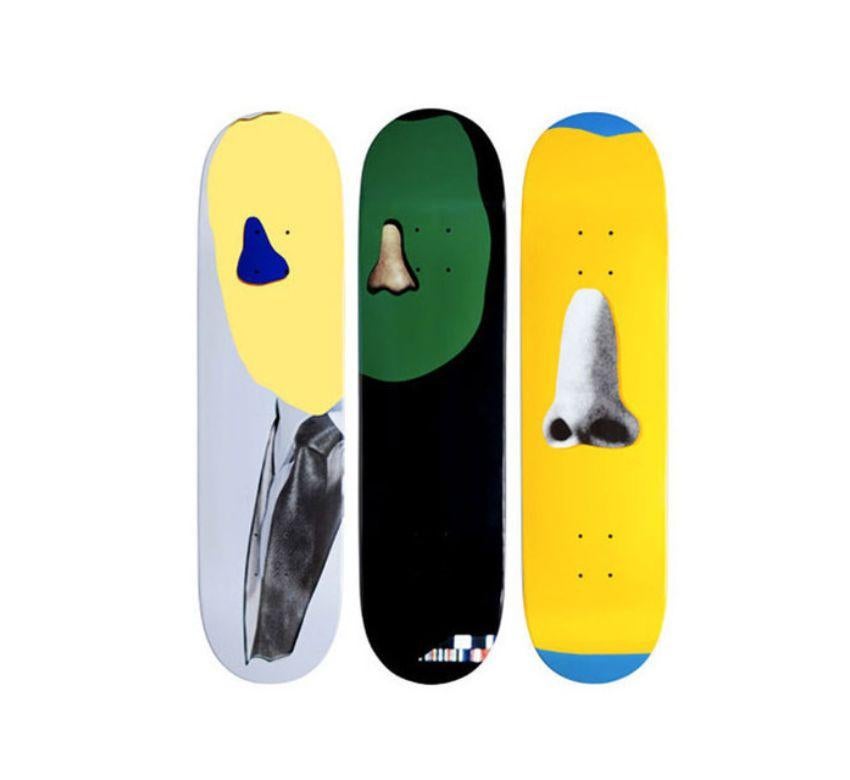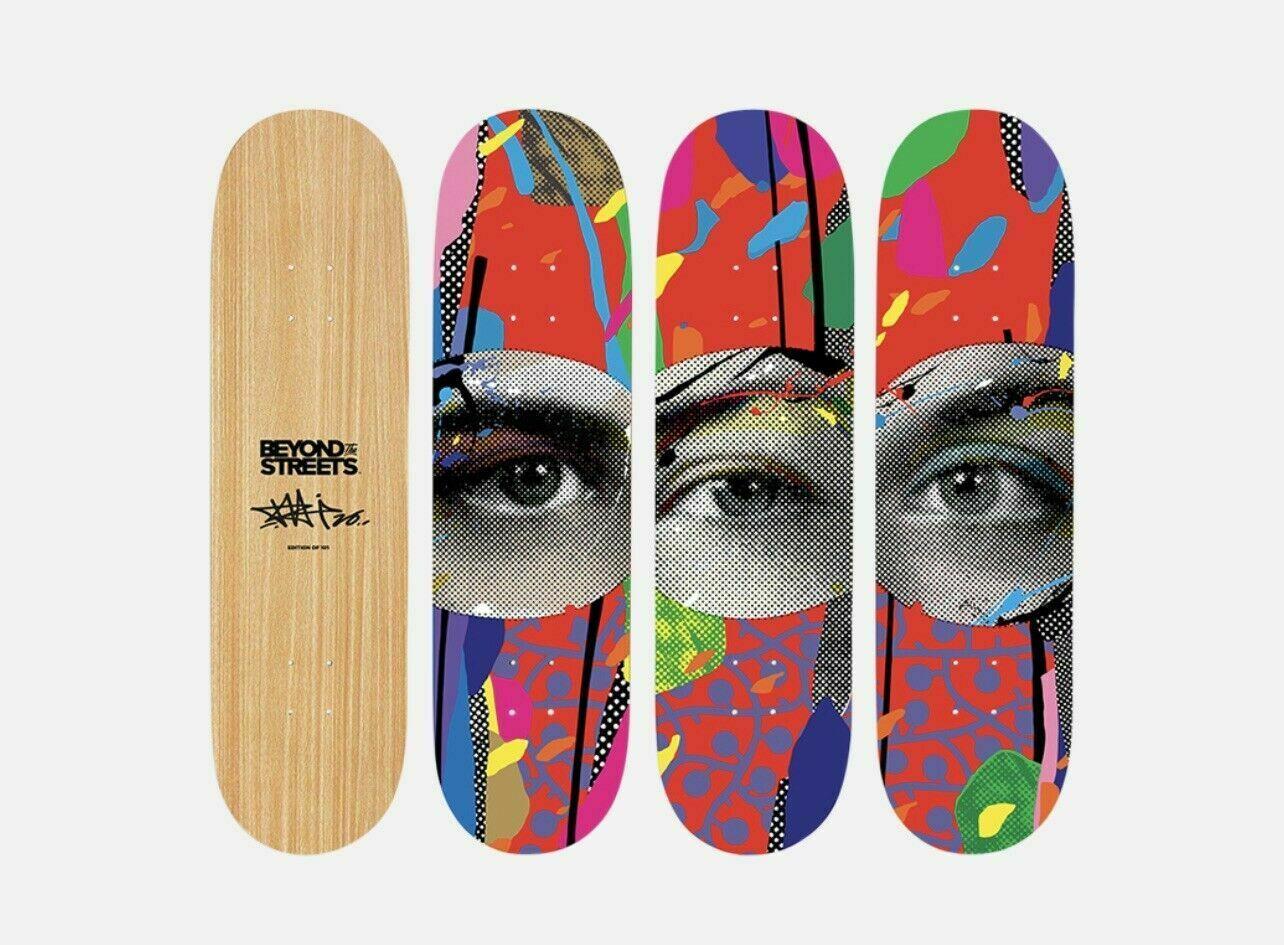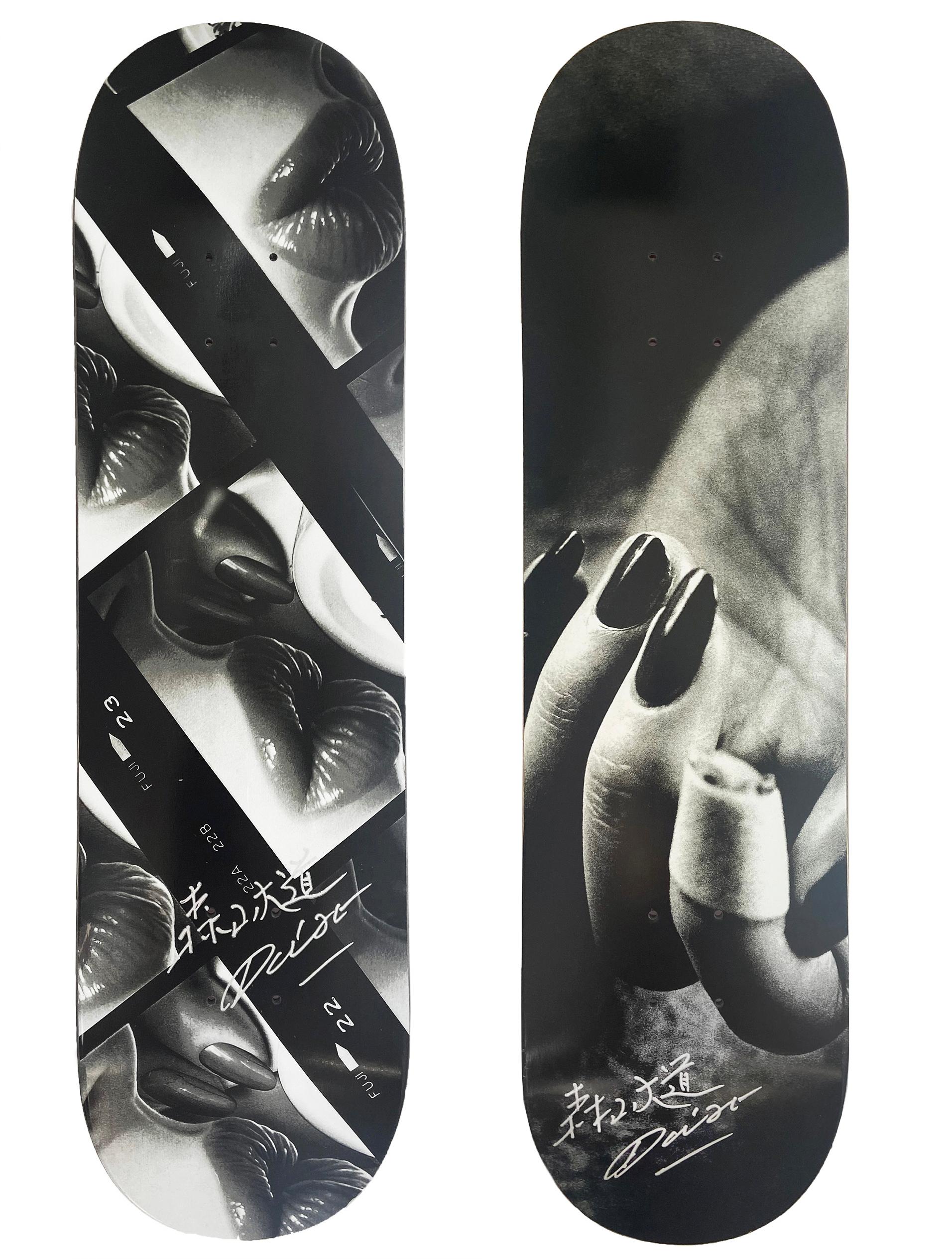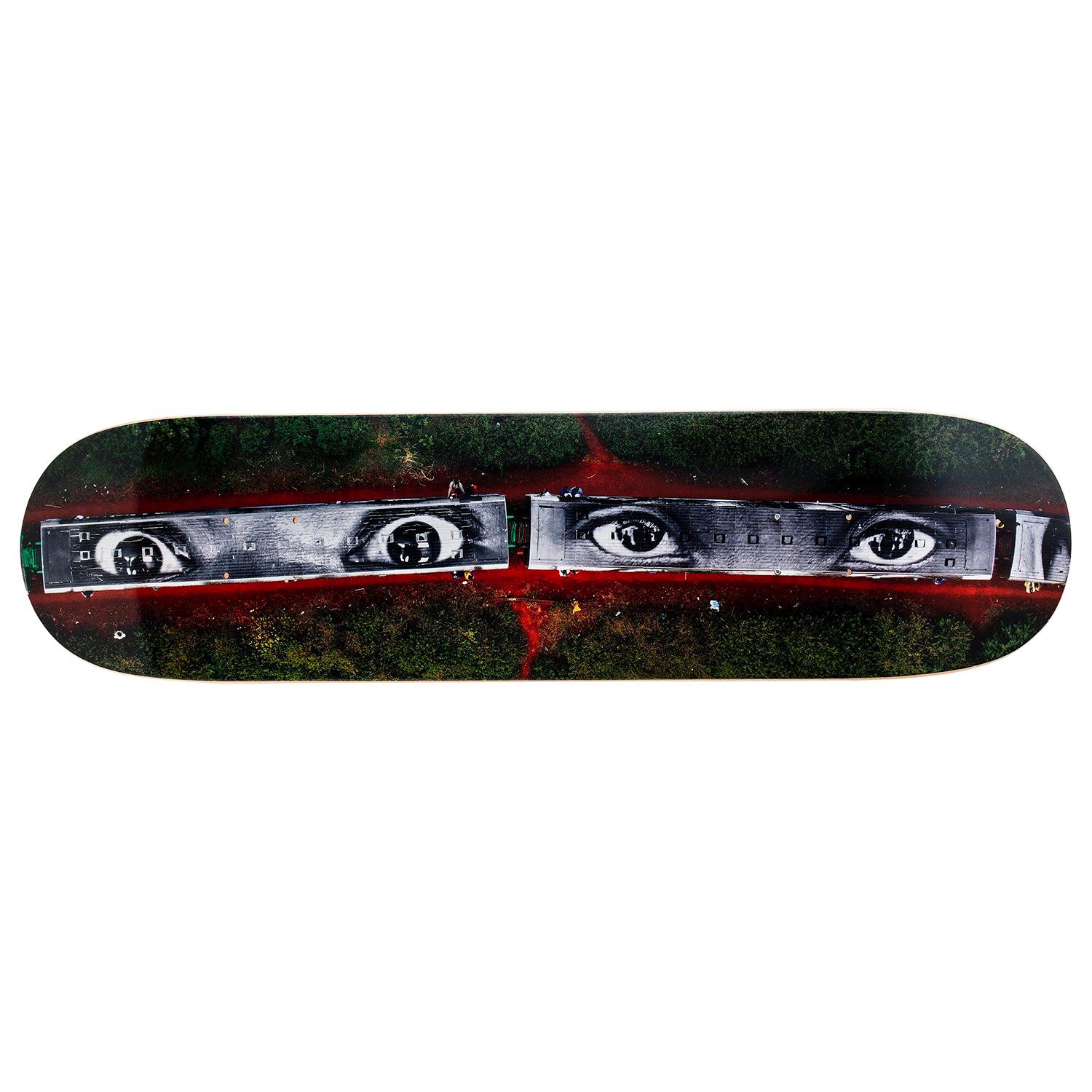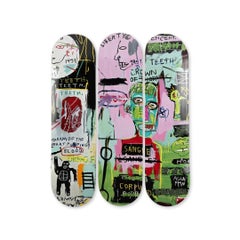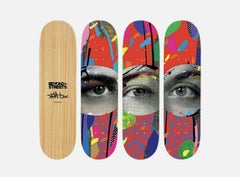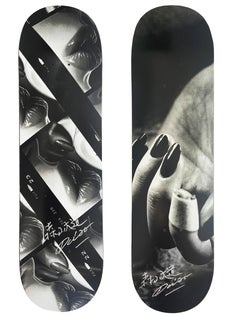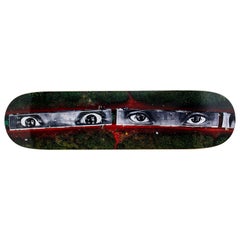Items Similar to JOHN BALDESSARI - Two Figures and Two Figures (Masked) Skate Deck Modern Design
Want more images or videos?
Request additional images or videos from the seller
1 of 3
JOHN BALDESSARI - Two Figures and Two Figures (Masked) Skate Deck Modern Design2025
2025
$969.37
£739.92
€825
CA$1,367.06
A$1,501.96
CHF 784.93
MX$17,912.14
NOK 9,939.40
SEK 9,259.39
DKK 6,288.08
About the Item
JOHN BALDESSARI - Two Figures and Two Figures (Masked) with Blue Shape
Date of creation: 2025
Medium: Digital print on Canadian maple wood
Edition: 30
Size: 80 x 20 cm (each skate)
Condition: In mint conditions and never displayed
Two Figures and Two Figures (Masked) with Blue Shape, created by John Baldessari in 1975, exemplifies his characteristic approach to conceptual art: the combination of cut-out photographic images with color interventions that alter the viewer’s perception. The piece depicts two masked figures alongside two other figures, over which Baldessari superimposes an abstract blue shape that disrupts the visual continuity and prompts the viewer to reconsider the relationship between figure, background, and color.
This work reflects Baldessari’s fascination with image fragmentation and the reinterpretation of meaning through minimal yet strategic interventions. The mask and blue shape introduce ambiguity, questioning identity, perception, and the context of seemingly ordinary images. Every element of the work —photography, color, and arrangement— contributes to a dialogue between presence and absence, realism and abstraction, humor and critical reflection.
The limited edition skateboards translate this conceptual piece into a tangible, collectible format, offering a unique experience that allows the artistic gesture of Baldessari to be observed, displayed, and enjoyed in a dynamic and engaging way.
In essence, this limited edition captures Baldessari’s philosophy: the boldness of reinterpreting the everyday, the interplay between chance and control, and the ability to transform a minimal intervention into an object of visual reflection. It is an elegant and contemporary way to experience conceptual art in an unexpected format that combines design, art, and functionality.
ABOUT THE ARTIST
John Baldessari (National City, California, 1931 – Los Angeles, 2020) was one of the most influential figures in contemporary art and a key force in establishing Conceptual Art in the United States. His work, poised between irony and erudition, reshaped our understanding of the relationship between image and language, challenging artistic conventions and opening paths that remain essential today.
Born to a family of European immigrants—his mother from Denmark and his father from Austria—he grew up in modest circumstances, far from the established art capitals. That distance from the traditional centers of culture shaped his outlook: he always regarded institutions with a blend of humor, irreverence, and critical sharpness. He studied art at San Diego State University and soon realized he did not want to confine himself to making conventional paintings.
A defining moment came in 1970, when he burned much of his early output in an action he titled the Cremation Project. With this symbolic gesture, he declared his intention to move beyond traditional painting and to focus instead on probing the very boundaries of art. From then on, he explored the intersections of photography, text, and collage, creating works that destabilized familiar modes of representation.
Baldessari became a master at using language as image and image as language. His photographs combined with textual fragments—phrases that appeared simple yet resonated with philosophical undertones—challenged both what we think we see and what we think we understand. He also developed his signature strategy of obscuring faces with colored dots: by erasing identity, he forced viewers to pay attention to everything else, shifting emphasis from the obvious to the overlooked.
His work never lost its sense of humor or its capacity to surprise. Baldessari often said art should be as serious as it is playful, and this fusion of intellectual rigor with wit made him a singular figure. His pieces invite audiences into a realm of clues, paradoxes, and visual puns that unsettle our certainties about what it means “to look.”
Beyond his artistic practice, he was an extraordinary teacher. At the California Institute of the Arts (CalArts), he mentored generations of artists who later became major voices, including David Salle and Barbara Kruger. His teaching was as influential as his art: rather than imparting techniques, he encouraged students to think, to question, and to find their own vision.
His career gained international recognition. In 2009 he received the Golden Lion for Lifetime Achievement at the Venice Biennale, and major institutions such as MoMA in New York, Tate Modern in London, and Museo Reina Sofía in Madrid have dedicated retrospectives to his work. Despite his acclaim, he always maintained a spirit of irreverence and accessibility, insisting that art should not be placed on an untouchable pedestal.
John Baldessari passed away in 2020 in Los Angeles, leaving behind a vast legacy. His work reminds us that art can be a site of critical reflection and, at the same time, a space for irony and play. He managed to mock conventions without trivializing them, and to turn the everyday into a laboratory of visual thought. In his hands, words and images learned to converse in unexpected ways—and audiences learned to see the world anew.
- Creation Year:2025
- Dimensions:Height: 31.5 in (80 cm)Width: 23.63 in (60 cm)Depth: 0.79 in (2 cm)
- Medium:
- Movement & Style:
- After:John Baldessari (1931, American)
- Period:
- Condition:
- Gallery Location:Madrid, ES
- Reference Number:1stDibs: LU1033117231432

About the Seller
5.0
Vetted Professional Seller
Every seller passes strict standards for authenticity and reliability
Established in 2011
1stDibs seller since 2018
183 sales on 1stDibs
Typical response time: 6 hours
- ShippingRetrieving quote...Shipping from: Madrid, Spain
- Return Policy
More From This Seller
View AllJOHN BALDESSARI - Throwing Three Balls... Skate Deck Modern Design Contemporary
By John Baldessari
Located in Madrid, Madrid
JOHN BALDESSARI - Throwing Three Balls in the Air to get a Straight Line (Best of Thirty-Six Attempts)
Date of creation: 2025
Medium: Digital print on Canadian maple wood
Edition: 3...
Category
2010s Expressionist More Art
Materials
Wood, Maple, Screen
JEAN-MICHEL BASQUIAT - Untitled Head (Skull) Skate Decks Urban Art Design
By Jean-Michel Basquiat
Located in Madrid, Madrid
Jean-Michel Basquiat - Untitled Head (Skull 2), 1982
Date of creation: 2024
Medium: Digital print on Canadian maple wood
Edition: Open
Size: 80 x 20 cm (each skate)
Condition: In mint conditions and never displayed
This triptych is formed by three skate decks made of 7 ply grade A Canadian maple wood.
© Estate of Jean-Michel Basquiat. Licensed by Artestar, New York
Untitled Head (Skull 2), 1982, is one of Jean-Michel Basquiat’s most iconic and enigmatic works, reflecting the artist’s complex relationship with life, death, and identity. Created during an early but intense phase of his career, this piece is characterized by its raw, expressive style, but also by its ability to convey a deep and multifaceted message.
The painting depicts a large skull, both grotesque and vibrant. The outlines of the skull are simple yet powerful, with angular strokes and dramatic lines. Basquiat uses a contrasting color palette, dominated by warm, earthy tones such as red, orange, and yellow, along with touches of blue and white. The skull seems to overflow with energy, full of marks and textures that evoke a sense of violence and chaos.
The skull is not only a symbol of death, but also carries connotations of internal struggle and personal suffering. Basquiat, known for his personal history marked by adversity, uses the figure of the skull to explore themes such as the fragility of life and the dehumanization of people, especially in African American communities. In his work, death is not presented merely as an abstract concept, but as something very real and close, connected to the everyday experience of those facing violence, racism, and poverty.
Through this piece, Basquiat also addresses identity and alienation, as the skull, with its exaggerated and distorted features, can be seen as a representation of an individual stripped of their humanity or cultural identity, particularly in the context of the experiences of Black communities in the United States. Basquiat often incorporates words, phrases, and symbols in his works that reflect his interest in cryptic messages and the deconstruction of meaning, and Untitled Head (Skull 2), is no exception.
The skull, often associated with mortality, in Basquiat’s context may also suggest the relentless presence of social oppression and how, in many cases, people’s lives are shaped by circumstances beyond their control. This approach to death is Basquiat’s way of engaging with the collective and personal traumas that defined his life, as well as the racial and social tensions of his time.
Untitled Head (Skull 2) is a work full of energy, with a strong symbolic charge, that breaks away from convention and offers a raw, direct view of life, death, and existential struggle. It is an example of how Basquiat used art to express his deepest emotions, challenging traditional representation and creating a piece that remains relevant today, both for its message and its unique style.
ABOUT THE ARTIST
Jean-Michel Basquiat (1960-1988) was one of the most influential artists of the 20th century, famous for his ability to fuse urban culture, social criticism and art history into a unique style. Born in Brooklyn, New York, to a Haitian father and Puerto Rican mother, his life and work were shaped by his multicultural heritage, the New York art scene and the social tensions of his time. Although his career was brief, his impact on contemporary art has been lasting and significant.
Basquiat showed an interest in art from an early age. His mother, Matilde Andrades, took him to museums and encouraged him to draw. At the age of seven, a car accident left him hospitalized for a time, and it was then that his mother gave him a copy of the anatomy book Gray's Anatomy, which influenced his fascination with the human body and its visual representation.
Despite his early talent, Basquiat's family life was turbulent. His mother was hospitalized for psychiatric problems and his relationship with his father, Gerard Basquiat, was troubled. This instability contributed to Basquiat dropping out of school at age 17 to pursue his artistic career on the streets of New York.
As a teenager, Basquiat joined the New York graffiti scene under the pseudonym SAMO (an acronym for "Same Old Shit"), which he used to sign his cryptic and poetic messages on the streets of Manhattan with his friend Al Diaz. SAMO's graffiti were a mixture of philosophical and social commentary on popular culture, capitalism and religion, and soon attracted the attention of the underground art scene.
In 1980, SAMO "died" when Basquiat and Diaz decided to end their collaboration, marking the beginning of Basquiat's transition from street graffiti to art galleries.
Basquiat emerged as a talent to watch in 1980, when he participated in the group exhibition The Times Square Show, which included other emerging artists from New York's Lower East Side scene. That same year, he attracted the attention of critics and collectors who saw in his work an electrifying blend of street art and neo-expressionism, the predominant movement of the time.
In 1981, art critic René Ricard published the influential essay The Radiant Child in Artforum magazine, which positioned Basquiat as one of the most promising artists of his generation. Shortly thereafter, he met renowned artist Andy Warhol, with whom he formed a close friendship and significant artistic collaboration. This association was instrumental in catapulting his career into the world of high art.
The collaboration with Warhol was a pivotal point in Basquiat's career. The two artists, although coming from very different worlds, shared a fascination with fame and popular culture. Together, they produced a series of works that combined Warhol's pop art icons with Basquiat's raw, spontaneous style.
However, this collaboration was also a source of controversy. Many critics accused Warhol of "exploiting" Basquiat, while others saw the collaboration as a creative dialogue between two genius minds. Although the criticism was mixed, there is no doubt that the relationship between the two artists helped cement Basquiat's reputation in the art world.
Basquiat's style is a unique amalgam of influences. His work is characterized by the use of dismembered human figures, skeletons and internal organs, evoking the fragility of the body and mortality. Basquiat also used symbols that alluded to African-American and African history, such as crowns, masks and references to historical figures such as Toussaint Louverture.
The use of text is another crucial aspect of his work. Words, phrases and numbers appeared in his paintings, often crossed out or overlapped, creating a sense of controlled chaos. These fragmented words provoked a non-linear reading of his works and conveyed multiple layers of meaning.
His art also reflected his concerns about racial issues, especially the place of people of African descent in Western art history and in society at large. The crowns that Basquiat often drew on his figures were a symbol of power and resistance, a way of proclaiming himself "king" in a world that had historically excluded black artists from the upper echelons of art.
In works such as The Death of Michael...
Category
2010s Pop Art More Art
Materials
Wood, Digital
JEAN-MICHEL BASQUIAT - In Italian. Skate Decks Pop Urban Art Design
By Jean-Michel Basquiat
Located in Madrid, Madrid
Jean-Michel Basquiat - In Italian
Date of creation: 2024
Medium: Digital print on Canadian maple wood
Edition: Open
Size: 80 x 20 cm (each skate)
Condition: In mint conditions and n...
Category
2010s Pop Art More Art
Materials
Wood, Digital
JEAN-MICHEL BASQUIAT - Horn Players, 1983 Skate Decks Pop Urban Art Design
By Jean-Michel Basquiat
Located in Madrid, Madrid
Jean-Michel Basquiat - Horn Players, 1983
Date of creation: 2024
Medium: Digital print on Canadian maple wood
Edition: Open
Size: 80 x 20 cm (each skate)
Condition: In mint conditio...
Category
2010s Pop Art More Art
Materials
Wood, Digital
JEAN-MICHEL BASQUIAT - Charles The First. Skate Decks Pop Urban Art Design
By Jean-Michel Basquiat
Located in Madrid, Madrid
Jean-Michel Basquiat - Charles The First
Date of creation: 2024
Medium: Digital print on Canadian maple wood
Edition: Open
Size: 80 x 20 cm (each skate)
Condition: In mint conditions and never displayed
This triptych is formed by three skate decks made of 7 ply grade A Canadian maple wood.
© Estate of Jean-Michel Basquiat. Licensed by Artestar, New York
This skateboard set reproduces Charles The First (1982), a key work by Jean-Michel Basquiat that pays tribute to Charlie Parker, the influential jazz saxophonist known as "Bird." Basquiat captures the frantic energy and complexity of Parker through his signature style, blending elements of Black culture, music, and the figure of the artist in a raw and powerful representation.
The original painting, executed with acrylics, oils, and pastels, presents a stylized figure that recalls both a portrait and a symbol. The face is fragmented, filled with quick strokes and vibrant colors, while the outline and details evoke both divinity and struggle. Basquiat uses his unique visual language to convey the chaos and beauty of Parker’s life, a metaphor for creativity as a form of resistance and expression.
Transposed onto the skateboard format, Charles The First becomes a dynamic work of art that not only celebrates the life of a musical icon but also merges contemporary art with urban culture. This piece transcends simple reproduction, inviting a connection between visual art and movement in the streets, with the same vigor and attitude Basquiat infused into his work.
ABOUT THE ARTIST
Jean-Michel Basquiat (1960-1988) was one of the most influential artists of the 20th century, famous for his ability to fuse urban culture, social criticism and art history into a unique style. Born in Brooklyn, New York, to a Haitian father and Puerto Rican mother, his life and work were shaped by his multicultural heritage, the New York art scene and the social tensions of his time. Although his career was brief, his impact on contemporary art has been lasting and significant.
Basquiat showed an interest in art from an early age. His mother, Matilde Andrades, took him to museums and encouraged him to draw. At the age of seven, a car accident left him hospitalized for a time, and it was then that his mother gave him a copy of the anatomy book Gray's Anatomy, which influenced his fascination with the human body and its visual representation.
Despite his early talent, Basquiat's family life was turbulent. His mother was hospitalized for psychiatric problems and his relationship with his father, Gerard Basquiat, was troubled. This instability contributed to Basquiat dropping out of school at age 17 to pursue his artistic career on the streets of New York.
As a teenager, Basquiat joined the New York graffiti scene under the pseudonym SAMO (an acronym for "Same Old Shit"), which he used to sign his cryptic and poetic messages on the streets of Manhattan with his friend Al Diaz. SAMO's graffiti were a mixture of philosophical and social commentary on popular culture, capitalism and religion, and soon attracted the attention of the underground art scene.
In 1980, SAMO "died" when Basquiat and Diaz decided to end their collaboration, marking the beginning of Basquiat's transition from street graffiti to art galleries.
Basquiat emerged as a talent to watch in 1980, when he participated in the group exhibition The Times Square Show, which included other emerging artists from New York's Lower East Side scene. That same year, he attracted the attention of critics and collectors who saw in his work an electrifying blend of street art and neo-expressionism, the predominant movement of the time.
In 1981, art critic René Ricard published the influential essay The Radiant Child in Artforum magazine, which positioned Basquiat as one of the most promising artists of his generation. Shortly thereafter, he met renowned artist Andy Warhol, with whom he formed a close friendship and significant artistic collaboration. This association was instrumental in catapulting his career into the world of high art.
The collaboration with Warhol was a pivotal point in Basquiat's career. The two artists, although coming from very different worlds, shared a fascination with fame and popular culture. Together, they produced a series of works that combined Warhol's pop art icons with Basquiat's raw, spontaneous style.
However, this collaboration was also a source of controversy. Many critics accused Warhol of "exploiting" Basquiat, while others saw the collaboration as a creative dialogue between two genius minds. Although the criticism was mixed, there is no doubt that the relationship between the two artists helped cement Basquiat's reputation in the art world.
Basquiat's style is a unique amalgam of influences. His work is characterized by the use of dismembered human figures, skeletons and internal organs, evoking the fragility of the body and mortality. Basquiat also used symbols that alluded to African-American and African history, such as crowns, masks and references to historical figures such as Toussaint Louverture.
The use of text is another crucial aspect of his work. Words, phrases and numbers appeared in his paintings, often crossed out or overlapped, creating a sense of controlled chaos. These fragmented words provoked a non-linear reading of his works and conveyed multiple layers of meaning.
His art also reflected his concerns about racial issues, especially the place of people of African descent in Western art history and in society at large. The crowns that Basquiat often drew on his figures were a symbol of power and resistance, a way of proclaiming himself "king" in a world that had historically excluded black artists from the upper echelons of art.
In works such as The Death of Michael Stewart...
Category
2010s Pop Art More Art
Materials
Wood, Digital
JEAN-MICHEL BASQUIAT - Both Poles. Skate Decks Pop Urban Art Design
By Jean-Michel Basquiat
Located in Madrid, Madrid
Jean-Michel Basquiat - Both Poles
Date of creation: 2024
Medium: Digital print on Canadian maple wood
Edition: Open
Size: 80 x 20 cm (each skate)
Condition: In mint conditions and never displayed
This triptych is formed by three skate decks made of 7 ply grade A Canadian maple wood.
© Estate of Jean-Michel Basquiat. Licensed by Artestar, New York
This skateboard set reproduces Both Poles (1982), an iconic work by Jean-Michel Basquiat that encapsulates the tensions running through his visual language: past and present, earth and sky, history and immediacy. The original piece, executed in acrylic, oil stick, and collage, presents a fragmented scene dominated by a symbolic mountain, a crescent moon, and charged elements such as a sickle and a post.
Here, Basquiat confronts “both poles” of his inner and outer worlds: excavation and invocation, memory and transmission. This edition brings that conceptual force into the urban language of skateboarding, becoming both a collectible object and a contemporary artistic statement.
Transposed onto the skateboard format, the work becomes a visual declaration that bridges art and street culture, while preserving the expressive and conceptual intensity of the original.
ABOUT THE ARTIST
Jean-Michel Basquiat (1960-1988) was one of the most influential artists of the 20th century, famous for his ability to fuse urban culture, social criticism and art history into a unique style. Born in Brooklyn, New York, to a Haitian father and Puerto Rican mother, his life and work were shaped by his multicultural heritage, the New York art scene and the social tensions of his time. Although his career was brief, his impact on contemporary art has been lasting and significant.
Basquiat showed an interest in art from an early age. His mother, Matilde Andrades, took him to museums and encouraged him to draw. At the age of seven, a car accident left him hospitalized for a time, and it was then that his mother gave him a copy of the anatomy book Gray's Anatomy, which influenced his fascination with the human body and its visual representation.
Despite his early talent, Basquiat's family life was turbulent. His mother was hospitalized for psychiatric problems and his relationship with his father, Gerard Basquiat, was troubled. This instability contributed to Basquiat dropping out of school at age 17 to pursue his artistic career on the streets of New York.
As a teenager, Basquiat joined the New York graffiti scene under the pseudonym SAMO (an acronym for "Same Old Shit"), which he used to sign his cryptic and poetic messages on the streets of Manhattan with his friend Al Diaz. SAMO's graffiti were a mixture of philosophical and social commentary on popular culture, capitalism and religion, and soon attracted the attention of the underground art scene.
In 1980, SAMO "died" when Basquiat and Diaz decided to end their collaboration, marking the beginning of Basquiat's transition from street graffiti to art galleries.
Basquiat emerged as a talent to watch in 1980, when he participated in the group exhibition The Times Square Show, which included other emerging artists from New York's Lower East Side scene. That same year, he attracted the attention of critics and collectors who saw in his work an electrifying blend of street art and neo-expressionism, the predominant movement of the time.
In 1981, art critic René Ricard published the influential essay The Radiant Child in Artforum magazine, which positioned Basquiat as one of the most promising artists of his generation. Shortly thereafter, he met renowned artist Andy Warhol, with whom he formed a close friendship and significant artistic collaboration. This association was instrumental in catapulting his career into the world of high art.
The collaboration with Warhol was a pivotal point in Basquiat's career. The two artists, although coming from very different worlds, shared a fascination with fame and popular culture. Together, they produced a series of works that combined Warhol's pop art icons with Basquiat's raw, spontaneous style.
However, this collaboration was also a source of controversy. Many critics accused Warhol of "exploiting" Basquiat, while others saw the collaboration as a creative dialogue between two genius minds. Although the criticism was mixed, there is no doubt that the relationship between the two artists helped cement Basquiat's reputation in the art world.
Basquiat's style is a unique amalgam of influences. His work is characterized by the use of dismembered human figures, skeletons and internal organs, evoking the fragility of the body and mortality. Basquiat also used symbols that alluded to African-American and African history, such as crowns, masks and references to historical figures such as Toussaint Louverture.
The use of text is another crucial aspect of his work. Words, phrases and numbers appeared in his paintings, often crossed out or overlapped, creating a sense of controlled chaos. These fragmented words provoked a non-linear reading of his works and conveyed multiple layers of meaning.
His art also reflected his concerns about racial issues, especially the place of people of African descent in Western art history and in society at large. The crowns that Basquiat often drew on his figures were a symbol of power and resistance, a way of proclaiming himself "king" in a world that had historically excluded black artists from the upper echelons of art.
In works such as The Death of Michael...
Category
2010s Pop Art More Art
Materials
Wood, Digital
You May Also Like
Supreme skateboard set of 3
By John Baldessari
Located in Washington , DC, DC
Supreme skateboard set of 3
Category
21st Century and Contemporary Contemporary Prints and Multiples
Materials
Screen, Board
$2,800 Sale Price
20% Off
Paul Insect I SEE Skateboard Deck Set Of 3 Beyond The Streets Signed XX/101 COA
By Paul Insect
Located in Draper, UT
Paul Insect:
Paul Insect is a UK contemporary artist. Best known for his collective named ‘insect’ that started in 1996 he is a collage, portrait master w...
Category
2010s Pop Art More Prints
Materials
Screen
Signed Daido Moriyama skate decks: set of 2 works ( Daido Moriyama photography)
By Daido Moriyama
Located in NEW YORK, NY
Hand-signed Daido Moriyama Skateboard decks: set of 2 individual works:
These works originated as a result of the collaboration between ...
Category
1970s Pop Art Sculptures
Materials
Wood, Lithograph, Offset
28 MILLIMÈTRES... Skateboard Deck by JR
By Prune Nourry and JR
Located in Jersey City, NJ
Fabricated by The Skateroom
Based on 28 MILLIMÈTRES, WOMEN ARE HEROES, ACTION IN KIBERA SLUM, « IN TO THE WILD », KENYA, 2009
One skateboard deck
7-ply Canadian Maplewood with scr...
Category
2010s Belgian Wall-mounted Sculptures
Materials
Maple
$350 / item
Untitled Larry Clark Kids Skateboard Skate deck
By Larry Clark
Located in New York, NY
Larry Clark
Untitled Larry Clark Kids Skateboard Skate deck, 2013
Screenprint on 7-ply Canadian maplewood skatedeck
Signed on the deck
31 × 8 inches
Long sold out 2013 skateboard dec...
Category
2010s Contemporary Figurative Prints
Materials
Maple, Mixed Media, Screen
The 4th Skate Deck by Henry Taylor
By (After) Henry Taylor
Located in Jersey City, NJ
The 4th is released in a limited edition size of 100. Based on a 2012 13-feet tall piece composed of two stacked panels. As Tatiana Istomina describes the work, ‘The upper [panel] shows the monumental form of a black woman in a white T-shirt; she holds what looks like a potato chip...
Category
2010s Contemporary Art
Materials
Wood

